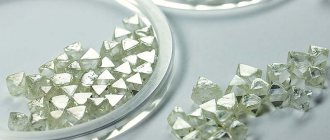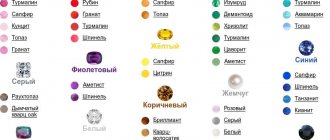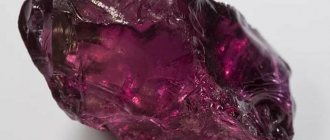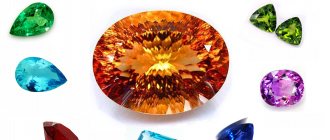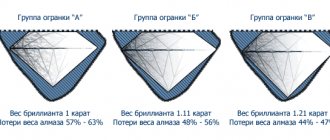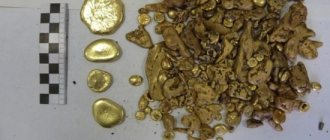Man began to use stones as tools about 2.6 million years ago: at first they were primitive, almost unprocessed pieces of rock that served as simple household tools. Later, our ancestors learned to make more advanced tools and even weapons from them, but still for many millennia the stones had an exclusively utilitarian purpose.
However, with the development of civilization, some breeds began to be endowed with a sacred and aesthetic function, and, as a result, they acquired a completely different material value. We tell you how the mining of various gems has evolved - from the first random finds to the modern risky business conducted by the heroes of the “Gem Hunters” project on the Discovery Channel from March 21 to Saturdays at 13:45 (Moscow time).
Deposits of famous stones
Very rare and beautiful stones are considered valuables. Among them, the most famous are sapphire, ruby, diamond, topaz and emerald. A large number of popular, but not precious minerals are included in the group of ornamental minerals. They look no less beautiful than the same rubies, they are just as popular in jewelry making, but they cost much less and are more common.
The most famous minerals each have their own deposit. Everything depends only on the composition of the rocks in the area. Most often, deposit development has been going on for several centuries in the same place; new ones are discovered very rarely. The most famous countries for the extraction of precious stones are as follows:
- Namibia and the Russian region - Yakutia - specialize in diamonds.
- Turquoise is mined in large quantities in Iran.
- Most of the rubies on the world market come from Pakistan.
- Sri Lanka is the place where you can buy sapphires and rubies.
- Topazes are mined in the Urals.
The Russian Federation is rich in various mineral resources, not only oil and gas, but also precious and semi-precious minerals. In addition, there are a kind of reserve workings - spare places in the event of complete depletion of large ones.
Main characteristics
Rarity
A quality that determines the frequency of occurrence of a mineral in nature. Precious stones possess it to the fullest. Some of them are so unique that they are found in one or several copies. However, this characteristic can easily change in one direction or another due to the discovery of new deposits, or vice versa - cessation of production due to depletion of deposits.
In this regard, carmeltazite is of particular interest - a stone that arrived on Earth from outer space. Also quite curious in this regard is the future development of mineral resources of nearby planets and asteroids, which may entail a change in the level of rarity of terrestrial gems.
Durability
It is this property of precious stones that allows them to remain unchanged for centuries. Durability is based on mechanical strength, determined by hardness, fragility, and resistance to mechanical, temperature and chemical influences.
beauty
The beauty of precious stones makes an indelible impression on any person. Thanks to it, value is formed, the desire to possess unique value is manifested and decorate it with skillful framing, creating unsurpassed jewelry. The concepts of beauty of precious stones include:
- color and reflective qualities,
- ability to take an elegant geometric shape,
- the ability to have a highly polished surface.
Types of deposits
There are only three types of deposits that are used throughout the world: open pits, placers and mine workings. A little more about each:
- Placers are places where valuable minerals were washed ashore by water flow. This occurs as a result of the natural separation of minerals from the underlying rock, and soil erosion is to blame. Extraction of precious and semi-precious stones from placers is carried out only by manual washing of slag.
- Open pits are a popular way to mine useful minerals and fossils from rock layers. The more time passes from the start of work, the deeper the quarry. Moreover, the largest of them is located in Chile, its depth is already 850 meters. If we talk about Russia, then there are giants here too. The largest diamond deposit can be considered the Udachnoe quarry; it is located beyond the Arctic Circle and fully lives up to its name.
- Mining workings are traditional underground mines where precious stones are extracted by manual labor. First, a test working is created; it is needed to determine the quantity and quality of stones, and only after that, if it has justified itself, workers are sent in.
Mining is rightfully considered the most dangerous method of mining. If safety rules are not followed, collapses may occur. Sometimes workers find an outlet of gas or underwater water, this does not lead to anything good.
Colored stones of the Transbaikal region
The site is dedicated to the problems of gemstone geology of Eastern Siberia - the Trans-Baikal region, within the borders of the Irkutsk region, the Republic of Buryatia and the Trans-Baikal Territory. In addition to geological reviews of the most interesting and significant deposits of gemstone raw materials, the pages of the site report on methods and techniques for processing various jewelry and ornamental minerals of Siberian deposits, the history of discoveries and developments of deposits of jewelry stones, photographs of minerals and information on the geological and gemological bibliography of the region with a brief annotation are provided published materials on this topic.
Site offers: collectible and rare samples of minerals and rocks of the East Siberian region are offered for sale in the online store (aquamarine, axinite, amethyst, apatite, beryl, lapis lazuli, corundum, marble onyx, jade, ophiocalcite, carnelian, sapphirine, serpentinite, tourmaline , chalcedony, chiastolite, charoite, brushes of magnetite and colored hematite, jasper and others).
Minerals: this section provides general information about the most interesting, common or rare minerals of the predominantly Siberian region. The information does not claim to be complete.
Stone cutting history of Siberia
...A motley crowd near the Obruchev monument in Irkutsk. You can hear the words: “cut, cabochons, raw materials...” - fragments of the surviving gemstone era of the “stagnant period” of the former country....
...It all started much earlier. Back in the 19th century, the handicraft industry of jet processing arose in Siberia. Small items of everyday use and decoration of the iconostasis of the main cathedral of Irkutsk brought fame to the Siberian jet. However, it took almost 100 years for a special mining and geological service to be created by order in 1966, the main task of which was targeted searches for deposits of precious and colored stones in the region... Articles
Modern articles devoted to semiprecious stone objects of Eastern Siberia: jade, lapis lazuli, collectible and rare minerals... Here the author of the site provides his subjective comments on some popular scientific publications of geological content, which from time to time appear in the information (printed and virtual) space (for example , “Minerals - Treasures of the Earth”, collections of minerals, etc.).
Photo archive
The most interesting photographs of minerals from various Siberian deposits
Polished ametrine plate with one of the veins of the pegmatite field of Uro-Suvo (Buryatia).
Minerals and their processing:
The section summarizes information about the most famous Siberian minerals, methods of their processing and use in jewelry and stone cutting. Technological processing methods for a specific mineral or rock are given in brief form.
Actinolite (jade) cat's eye is a parallel-fibrous, massive, usually translucent material ranging from light yellowish-green to golden brown and brownish-green in color, occurring as veins and lenticular inclusions in ordinary jade. In the region, such material comes in noticeable quantities from the Ospinskoye deposit of the Eastern Sayan...
Personalities
Outstanding geologists, scientists and practitioners, professionals and amateurs who have made a significant or decisive contribution to the search, exploration and development of deposits of precious, colored and collectible stones in Siberia.
Bibliography
A list of works on the gemstone theme of the Transbaikal region, with a brief annotation by the author of the review...
Volin A.I. From a trip to various deposits in the Baikal region. Irkutsk, 1930
Manganese ores along the river are briefly described. Tbilti and a visit to lapis lazuli deposits in the Baikal region. The Malo-Bystrinskoye field is assessed as the most promising of all known.
Dravert P. Opals in the Yakut region. Kazan, 1915
Mention of chalcedony group minerals, opals, petrified wood, carnelian and other minerals along the Vilyui and Lena rivers and their tributaries.
Banknotes: Excerpts, banknotes, quotes from statements of famous people found in published materials on gemstone topics of the Siberian region, Russia, the world... about geology, life...
Lawlessness in geology: Modern morals in the geological community, maintenance and licensing of geological exploration, legislation, government chicanery...
Mining enterprises
Most often, a deposit of precious stones is discovered completely by accident, without depending on technical means or exploration by scientists. Scientists can specifically look for only one stone - diamond, it brings more money and is a very valuable production material. If an exploration team stumbles upon a deposit or illegal mining of precious stones in Russia, for example, sapphires, then they will simply inform their superiors and continue their search. A mining enterprise is built on the site of any source found.
"Witnesses of the Kimberlite Pipe"
However, perhaps today we do not know everything about our home planet. Konstantin Garanin once again confirmed: almost all diamond deposits known today are associated with kimberlites, which are confined to the Archonian - with an Archean basement and a cratonization age of 2500 million years or more.
The second priority is protons. The Australian Argyle field is certainly an interesting phenomenon. This is a very rich site, but it is still the only lamproite pipe in the world where diamonds are mined on an industrial scale. True, Mr. Garanin noted that in the coming years it will be fully developed.
“There is a lot of discussion about identifying additional sources of rough diamonds, but until now such work has not been carried out on an industrial scale. However, we all know about the Popigai crater, and Victor Masaitis once determined that the resources of such a structure can exceed in weight the resources of all diamonds, which are concentrated in all diamond-bearing bodies of other kinetic structures in the world.
In our company, the level of subsurface knowledge is very high, and our analysts focus on kimberlite deposits. However, we are waiting for discoveries from our scientific colleagues to substantiate the industrial diamond potential of other types of mineral raw materials,” said Konstantin Garanin.
Deputy Head of Center-Sibnedra Ivan Kurbatov believes that such active interest in kimberlite structures - especially in Russia - has not only a geological, but also a historical basis.
It's no secret that most modern mineral deposits, including precious metals and stones, were discovered by Soviet geologists in the middle of the last century. They discovered - in the sense they put it on the map, the development of many of them began much later, and some have not yet begun at all.
The Union began searching for diamonds immediately after the war, the work went on a wide front, factories and aircraft sites appeared in the once uninhabited taiga, and the search itself turned into some kind of production competition.
“1949 was a milestone year. Firstly, this is the year of the discovery of Yakut diamonds. Well, secondly, it was in April of this year that big changes began in the USSR Ministry of Geology, which ricocheted through the diamond miners. The Minister of Geology changed, and this event brought a lot of confusion to the organization of work. I would call the introduction of strict secrecy the biggest negative innovation,” says Ivan Kurbatov.
Geological organizations, says Ivan Ivanovich, were transferred almost to martial law - with security, seals and a regime of secrecy. But geology is a science where much is built on analogies, and if geologists do not exchange information, they can easily miss something important.
Ivan Kurbatov told how in the 1980s he came across a brochure about unconventional types of diamond-bearing lamproite rocks in Australia. It was marked “For official use only.”
“So many geologists simply did not have this knowledge. As a result, in the geological environment, among those who dealt with diamonds, a “caste of witnesses to the kimberlite pipe” was formed, possessing some sacred knowledge. I believe that this state of affairs had a negative impact on the effectiveness of the work, primarily in those regions where diamond ore bodies and pipes were not found,” says Ivan Kurbatov.
Types of enterprises
Of course, everything in this world is divided into groups, and mining organizations have not escaped this trend. There are several definitions that explain how and what an enterprise produces:
- Mine - quarries and mine workings specializing in the extraction of gems.
- Mines are enterprises that obtain minerals by manually working mines.
- Mines are fairly large organizations in which the extraction of precious stones and metals is carried out open pit or underground.
All these concepts are often confused with each other. Few people delve into facts and explanations, and most people simply don’t care.
Where do diamonds come from?
The process of formation of a priceless stone is laid deep in the bowels of the earth. What does a diamond come from? At a depth of 100-200 km, under high temperature and pressure, carbon is converted into diamond over a long period of time. Gradually, thanks to certain processes occurring in the earth's crust, diamond deposits are forced to the surface. Such exit routes are called kimberlite pipes (after the name of the rock “kimberlite”). There are several thousand of these types of pipes on the planet, but mining diamonds in each of them is not always profitable. Therefore, only some of them are used for their intended purpose.
Available methods
Little has changed since ancient times, and the various methods of mining precious stones have undergone few changes. Until now, as before, mines are dug with shovels, and everything that is mined is lifted for sorting in baskets on ropes. Most often, the start of a mine takes place near rivers, where the rock can be washed. As a result of washing, gems are most often found, but only a couple per basket, and again the whole process starts over again. The finds of such searchers are sold at auctions or local territorial markets. And the already purchased stones are processed by jewelers and sold to large or not so large stores. This is how private mining of precious stones takes place in the world.
Gems without any impurities are considered the most valuable on the world market. But only a specialist can determine whether a stone is clean; it is he who carries out the preliminary processing of jewelry and metals. Every jeweler must be a true professional, he must know all the properties of stones and minerals, this is necessary in order to recognize a fake.
Serendipity in Ceylon
One of the oldest, richest and most famous gemstone mining regions was Sri Lanka, which retains this status today. Here, as early as 600 BC, sapphire, ruby, garnet, alexandrite, amethyst, greenish-yellow cat's eye, magical moonstones, topaz, tourmaline - more than 80 rocks in total - became known. It is curious that one of the former names of the island, Serendip, is in some way associated with this fishery. This is what the Persians called it, and other peoples in a similar way: the Romans - Serendivi, the Arabs - Serrandib.
The term “serendipity” comes from this form, denoting instinctive insight, the ability, by drawing deep conclusions from random observations, to find something that was not intentionally sought. The name Serendip has its roots in the ancient Greek designation of the island - Silenus Diva, as well as names in many European languages: Latin - Seelan, Portuguese - Ceilão, Spanish - Ceilán, French - Selon or Ceylan, Dutch - Zeilan, Ceilan and Seylon, English - Ceylon and well known in Russian Ceylon.
Mines in Sri Lanka / ©yaustal.com
Such intuitive insight and the ability of the island’s inhabitants to find what they were not looking for were, of course, in the nature of fairy tales and legends, but the amount of jewelry mined here since time immemorial is a very real fact. One of the first (late 13th century) mentions of a fabulously rich region and an incredibly developed industry belongs to the Italian traveler Marco Polo. In his “Book on the Diversity of the World,” he notes that the famous mortar (Buddhist architectural and sculptural religious building) of Ruwanveli in the city of Anuradhapura is decorated with a ruby as thick as a human hand.
Marco Polo also briefly described the process of mining precious stones in Ceylon: according to the traveler, placers were washed in trays. In the 18th century, the “History of Ceylon” by Captain Ribeiro was published, which, among other things, says: “to catch gems in the rivers, the Moors lower nets into the water, in which they find topazes, rubies and sapphires, which are sent to Persia in exchange for other goods.” .
Marco Polo / ©iknigi.net
Another toponym is associated with the mining of precious stones in Sri Lanka - Ratnapura, which translated from Sinhalese means “city of gems”. It was a rich fishing center: here, on an area of 2 thousand square kilometers, there were five large and a dozen small placers, which were famous for “cat's eye”, aquamarines, amethysts and sapphires. The productive formation varied in depth from 1.5 to 15 meters, and was developed mainly by open-pit mining, that is, using the technology of washing loose material.
For this purpose, special trays made of intertwined reeds or bamboo were used. It was here, on the outskirts of Ratnapura, that one of the largest sapphires, the Blue Beauty of Asia, was found in 1926. It weighs more than 400 carats and was sold for a record $17.5 million at Christie's in Geneva in 2014. The 536-carat Star of India sapphire also comes from Ratnapura; today it is on display in a museum in New York.
“Blue Beauty of Asia” / ©2.bp.blogspot.com
Now the technology for extracting stones in Sri Lanka remains the same as it was centuries ago. Until recently, excavators and other heavy equipment were used here, but they left behind lakes and swamps. Therefore, today the entire process is based on manual labor - even mines are dug right in the rice fields with picks and shovels, and the river bank is still considered the best landmark. Of the automation equipment, only pumps are used that constantly pump out water: if they are turned off, the mine will inevitably flood in about an hour.
Sometimes, when deep mines are laid, additional measures are required - for example, forced air supply using a motor pump. The rock is lifted from the mine in baskets or buckets using a rope system, after which it is methodically washed under running water or in a river. Then other people take on the matter, who have more painstaking work: they try to find precious stones in the ground among ordinary stones.
Ratnapura / ©avatars.mds.yandex.net
Sometimes, after two or three months of such exhausting and monotonous work, not a single stone can be found, and money still needs to be paid to the state: to obtain a mining permit in Sri Lanka, you will have to pay 5 thousand dollars a year - that’s how much a mining license costs precious stones. However, even when prospectors manage to find a promising crystal, this does not mean that they will instantly become rich.
The scheme works like this: after the end of the shift, workers take the loot to the market, but until the stone is processed, it is impossible to understand its true value. Therefore, they don’t give much money for such “raw materials”. Of course, if the gem turns out to be pure and devoid of any foreign impurities, the buyer will get a serious sum for it when selling it, only the ordinary mine worker who found this stone will no longer know about it. To avoid such situations, many miners work as family contractors, where everyone has their own specialization: someone digs mines, someone lifts rock, someone washes and sifts the soil, and someone processes it - this way, if you are lucky, you can avoid loss money.
Sapphire “Star of India” / ©i.pinimg.com
The heroes of the “Gem Hunters” program, which airs from March 21 on Saturdays at 13:45 (Moscow time) on the Discovery channel, risk facing similar difficulties. They travel to exotic locations in search of treasure, from the ruby mines of Vietnam to the bustling street markets of Madagascar. A gem dealer, a jewelry expert, and a geologist travel to different countries in search of the largest, brightest, and most expensive stones in the world.
But often they face dangers: they need to thoroughly know the rules of entry and exit from the country, be able to find and evaluate local players, establish the authenticity of the goods, negotiate a purchase at the best price and, of course, cut the stones themselves - otherwise the purchase will completely lose the price.
Gem Hunt / ©Discovery Channel
Sri Lanka
This country has already been mentioned as a center for the extraction of special types of precious stones. But there are several noteworthy nuances in the developments themselves. The extraction of precious stones there is done manually; automation is used only as pumps for pumping out groundwater. The mines themselves are dug directly in the rice fields; large working equipment is not used during excavations, so as not to create swamps.
Sri Lanka is famous for its variety of minerals and stones; about half of the varieties of all known jewelry can be found here. But the state is not involved in the development of deposits; for this there are special prospectors who pay an official license annually.
Fake Nero emeralds, Brahmin diamonds and Cleopatra's cauldrons
In ancient times, it was less about mining and more about the chance discovery of precious stones: bright pebbles that stood out against the background, for example, of gray river pebbles, inevitably attracted people’s attention. They were picked up in streams and on slopes when the rock accidentally came to the surface, gradually being released under the influence of erosion and going down along with the flow of water. Such stones were used as jewelry, amulets, attributes of power, or for ritual purposes. Later, when it became clear where beautiful gems come from, they began to be mined purposefully, using simple shovels and picks made of stones, strong sticks and deer antlers.
Such excavations were superficial because the tools were primitive. However, then, apparently, it already became obvious: if several gems were discovered in a small area in the neighborhood, this area is potentially rich in other valuable finds. In addition to collecting gems directly from the surface, they were also looked for in rock crevices. The crystals that grew on the rock were broken off using more advanced tools - chisels, chisels, picks or crowbars.
The legendary scarab beetle on the chest pendant of the pharaoh / ©kulturologia.ru
But gems became truly valuable relatively recently: emeralds in India were known 2 thousand years BC, and diamonds - 1000-500 years BC. It is interesting that the Hindus divided diamonds, like people, into four varnas: the most expensive - brahmans - white transparent crystals, then came rocks with a reddish tint - kshatriyas, followed by greenish or yellowish vaishyas and the least valuable, gray and cloudy - shudras.
On the Sinai Peninsula, turquoise began to be mined approximately 3400 BC, and in the burials of Ancient Egypt, archaeologists found crafts using lapis lazuli, amazonite, garnet, emerald, and amethyst. For example, in the tomb of Tutankhamun, many jewelry trimmed with turquoise and lapis lazuli were discovered, and the legendary scarab beetle on the pharaoh's chest pendant was carved from green volcanic glass.
After humanity invented not only statehood, but also the exploitation of other people's labor, slaves were everywhere engaged in mining precious stones. Thus, in Egypt, near Mount Zabara, a deposit is known that was developed, according to written monuments, already in 1650 BC. Another deposit near Aswan, several tens of kilometers from the Red Sea coast, was developed under Pharaoh Sesostris III about 37 centuries ago. Slave miners dug shafts up to two hundred meters deep - up to 400 people could be here at the same time. Moreover, all work was carried out in complete darkness, since it was believed that emerald is afraid of light.
Afterwards, the rock was split into pieces and smeared with olive oil to distinguish the precious crystals. These mines of Aswan later became known as the cauldrons, or mines of Cleopatra, since the last queen of Hellenistic Egypt had a weakness for emeralds and considered them the only stones truly worthy of her beauty and greatness. The ancient Roman emperor Claudius Nero also treated emeralds with trepidation. It was a large, deep green stone, cut in the shape of a lens. Nero used it as a monocle when he watched the battles of gladiators in the arena - however, already in the 20th century, French scientists established that it was not an emerald at all, but a perfectly clean and polished chrysolite.
Simple mining methods
The most primitive way to get precious stones was and is the collection of mineral deposits near rivers. Everything is simple here, crystal growths are right on the surface, they are not difficult to find. Prospectors knock down valuable minerals with a hammer or chisel. But they try not to use explosives, so as not to damage valuable materials.
There is a way to extract it directly in the water. The rivers are accelerated in a special way, and the workers stand and muddy the bottom with long poles. As a result, all the silt and sand are washed away, and the precious stones remain at the bottom.
No matter how many years pass, the mining of precious stones will remain a profitable business, especially for large corporations. But private seekers have little luck; rarely can any of them get very rich from simply excavating sand and sorting out pebbles. In Russia, if a person finds a deposit of precious minerals, he is required to report it to the authorities.
Diamond Geography
The bulk of world diamond production (about 97%) is provided by the already mentioned Russia, the countries of South Africa, Canada and Australia.
“In 2019, global diamond production amounted to 141 million carats. These are not peak values, but the indicators are quite high,” noted the chief geologist of AK Alrosa, Konstantin Garanin, speaking at the webinar “Geology and mineral resource base of diamonds in Siberia and the Arctic regions of Russia.”
The online conference “Geology and mineral resource base of diamonds in Siberia and the Arctic regions of Russia” was held as part of the media educational project “Geowebinar”, which began its work in April of this year. At its origins were the Society of Russian Experts on Subsoil Use, the Faculty of Geology of Moscow State University and the international mining and geological forum Mingeo Siberia and the online investment platform “Territory of Resources”. Currently, the project regularly hosts online conferences, lectures and seminars for mining industry professionals.
Our country is the undisputed leader in diamond mining, although only two players represent Russia. A player, to put it mildly, unequal. About 42 million carats are mined in Russia every year, 5 million of which come from AGD Diamonds, the rest of the volume is mined by the global diamond giant Alrosa.
It is noteworthy that the map of diamond resources is not identical to the map of their production. Regions such as West Africa, Asia, and the USA are emerging as promising.
“It seems that the geography is wider - but this is only on one side. On the other hand, in recent decades it has not been possible to bring new fields into development. Although there have been attempts to work in the northern regions of Australia, as well as in Brazil. As a result, the main diamond mining is still concentrated in the leading countries,” commented Mr. Garanin.
In general, with regard to the volume of global diamond resources, the figures given in various sources differ significantly, including because the methodology for estimating resources differs. The consolidated estimate of experts is about 5 billion carats.
And here Russia is ahead of the rest: according to JORC, we have 1162.5 million carats of resource reserves - this is 22% of the world. A very promising diamond country is Botswana (19%), however, there is still active mining going on here. 12% comes from Angola and 8% from South Africa, which makes the African continent an incredibly attractive region for miners. The Americas contain 11.5% of the world's resources, of which 10% are in Canada.
Mikhail Dyagilev, Chairman of the Committee for Supporting Entrepreneurship in the Field of Mining, Production, Processing and Circulation of Precious Metals and Precious Stones of the Russian Chamber of Commerce and Industry, General Director of OJSC Krastsvetmet
“What do precious metals and stones have in common? Firstly, we have a common law. Secondly, the general regulator is the Ministry of Finance. If we talk about the scale of the industry, diamond mining accounts for approximately 1/7 of the consolidated precious metals and gemstones industry.
According to my estimate, the annual turnover of diamonds in Russia reaches 300 billion rubles, and the entire turnover of precious metals and stones reaches 2 trillion rubles. Of this, about 1.5 trillion rubles is the turnover of gold. I now mean all mined and produced precious metals, including secondary production, which entered the foreign and domestic markets and constitute the revenue of companies operating in the industry. But if in our country there are two companies involved in diamonds, then there are more than 550 in precious metals.
Almost all of them mine gold, and only a few companies are involved in platinum metals. Diamonds are very similar to gold in their meaning and significance for people: they are used in the production of jewelry, in addition, they are an investment item. After all, gold is also mainly a non-industrial metal. 85% of gold is sent to the investment sphere or for jewelry purposes, and is stored in the form of banking products.”
